Pearls have been treasured for centuries, but with high-quality imitations flooding the market, it can be difficult to tell if a pearl is real or fake. Natural and cultured pearls are formed through natural processes, resulting in unique imperfections that distinguish them from fake pearls, which are typically uniform and smooth. Fake or imitation pearls are often designed to look like the real thing, but there are distinct differences. Whether you’re considering a new purchase or verifying a pearl in your collection, knowing how to identify genuine pearls is essential.
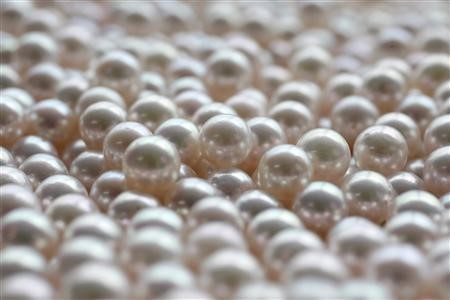
At The Pearl Source, we specialize in authentic pearls, guaranteeing the quality of every piece of pearl jewelry. In this guide, we’ll walk you through the key differences between real and imitation pearls and provide simple tests you can do at home to determine their authenticity.
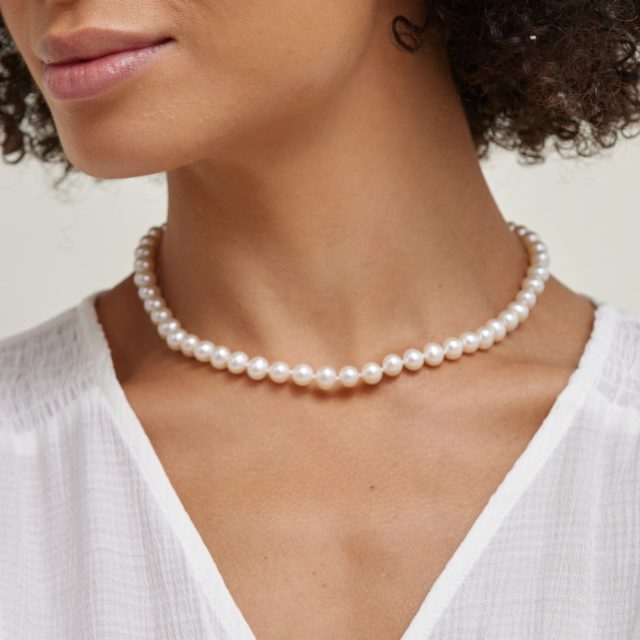
Real pearls are organic gemstones formed by mollusks in freshwater or saltwater. They fall into two categories: natural pearls, which form without human intervention and are extremely rare, and cultured pearls, which are farmed by inserting a nucleus into the oyster. However, whether a pearl is natural or cultured, it is still considered authentic.
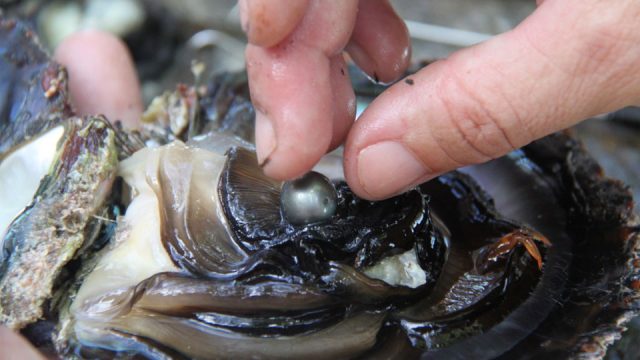
In contrast, imitation pearls are synthetic, lacking the natural luster and irregularities of real pearls. Genuine pearls have a soft, deep glow and subtle surface ridges, distinguishing them from the flawless, uniform appearance of fakes.
Real pearls—whether natural or cultured—form inside mollusks and develop organic features unique to each pearl. Imitation pearls, on the other hand, are man-made beads designed to mimic the appearance of real pearls. They are typically made from materials such as glass, plastic, or ceramic, and can be coated with synthetic material to mimic a pearl’s luster. While they can be crafted to look convincingly similar to real pearls, there are key differences that can help you identify them.
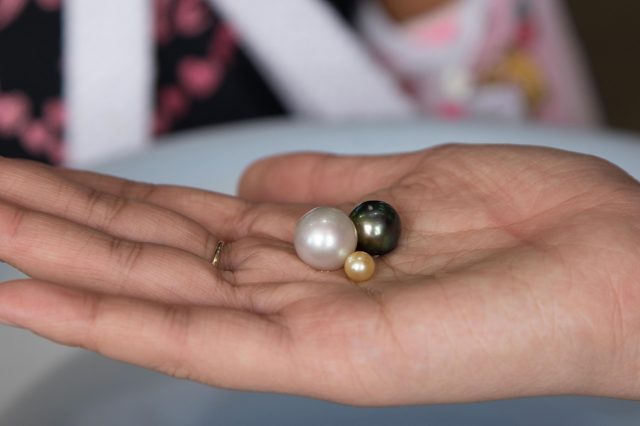
| Feature | Real Pearls | Fake Pearls |
|---|---|---|
| Surface | Slight imperfections, natural texture | Flawless, overly perfect surface |
| Luster | Deep, soft glow with natural depth | Artificial, overly shiny, glassy reflection. Lacks natural depth |
| Shape | Slight variations, rarely perfectly round | Perfectly round, highly uniform shapes |
| Weight | Heavier due to organic nacre layers | Lighter due to synthetic materials |
| Temperature | Cool to the touch, warms with wear | Room temperature or plastic-like feel |
| Drill Holes | Clean with visible layers of nacre | Rough or chipped, coating may peel around drill holes |
If you’re unsure whether a pearl is real or not, there are thankfully some simple tests to help you determine authenticity. These tests can be used on their own or in tandem with each other to help you learn more about whether a pearl is real, and can be used on either individual pearls or pearl jewelry.
After a while, your pearl identificaiton skills will improve, and it will become easier to trust whether a pearl is real or not!
Best for: Quick identification
Tip: This method works best on loose pearls or strands that aren’t heavily coated with oils or polish.
Best for: Spotting telltale natural features
Expert Insight: No two real pearls are ever identical, even in a strand.
Best for: Checking density
Note: While glass-based fakes can be heavier than plastic imitations, they still lack other real pearl characteristics like warmth and organic texture.
Best for: Quick touch verification
Why? Pearls naturally retain coolness due to their organic composition.
Best for: Checking strand authenticity
Best for: Observing luster and depth
Fact: High-quality real pearls reflect light in a way that creates a “halo effect” around their surface.
If you’re still uncertain, a jeweler or gemologist can provide expert verification through:
Some imitation pearls look remarkably real, but there are key differences:
| Type | Description | How to Identify |
|---|---|---|
| Glass Pearls | Coated glass beads mimicking luster | Slightly heavier, surface can chip |
| Plastic Pearls | Lightweight costume jewelry pearls | Very light, lacks cool temperature |
| Shell Pearls | Made from ground oyster shell | Too smooth, lacks organic imperfections |
| Majorica Pearls | High-end simulated pearls from Spain using fish scales | Thick coating, no true nacre structure |
| Synthetic Pearls | Man-made pearls with uniformity and smooth texture | Lack of organic imperfections, uniform surface, and different tactile qualities |
Real pearls are formed naturally inside mollusks, either in freshwater or saltwater environments. Each type has distinct characteristics, including variations in color, size, luster, and rarity. Below, we explore the four primary types of cultured pearls found in fine jewelry.
Akoya pearls are the most traditional and iconic white pearls, prized for their near-perfect roundness and brilliant shine. Unlike imitations, Akoya pearls are often bead nucleated cultured pearls, known for their bright luster and perfect round shape, making them highly desirable in jewelry. These saltwater pearls are primarily farmed in Japan and China, using the Pinctada fucata martensii oyster.
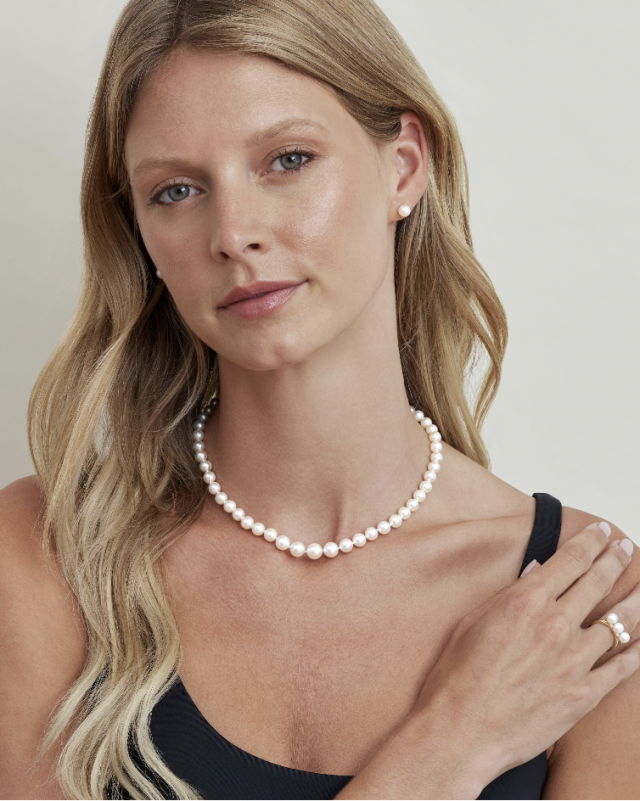
Tahitian pearls, often referred to as “black pearls,” are cultivated in the warm waters of French Polynesia, primarily in the Pinctada margaritifera oyster. Unlike dyed pearls, Tahitian pearls develop their dark colors naturally, making them one of the rarest and most exotic pearl varieties.

South Sea pearls are the rarest and most valuable cultured pearls, cultivated in the warm waters of Australia, Indonesia, and the Philippines. They are grown inside the Pinctada maxima oyster, the largest pearl-producing oyster species.
Freshwater pearls are cultivated in lakes, rivers, and ponds, primarily in China. Unlike saltwater pearls, freshwater pearls are grown in mussels rather than oysters, which allows them to produce multiple pearls at once.

Investing in natural or cultured pearls means owning a timeless, valuable gemstone that retains its beauty for generations. Unlike imitations, genuine pearls develop character over time, making them even more special.
When it comes to checking if a pearl is real, you’re likely to be looking at a complete piece of jewelry, such as a necklace. In this case, inspecting a pearl necklace is an essential step in determining its authenticity and ensuring you are investing in a high-quality piece. Here are some key aspects to look for:
By carefully inspecting a pearl necklace, you can determine its authenticity and ensure that you are buying a high-quality product that will stand the test of time.
Yes! Cultured pearls are grown inside oysters or mussels, just like natural pearls. The difference is that farmers help the process by inserting a nucleus to stimulate pearl formation.
Rarely. While some high-end Akoya or South Sea pearls come close, real pearls often have minor shape variations.
Yes—many imitation pearls have a painted or coated surface that can wear away over time, exposing the material underneath.
Yes, but some lower-quality freshwater pearls may be dyed or treated to enhance color.
The Tooth Test and Surface Inspection are the quickest ways to spot fakes at home.
At The Pearl Source, we guarantee authentic, high-quality pearls that are hand-selected and responsibly sourced. Whether you’re looking for timeless pearl necklaces, elegant earrings, or statement bracelets, our collection offers certified, real pearls at exceptional value.
Signup now and receive an email once I publish new content.

Content Writer and Editor at The PearlSource
Kate Muirhead is the editor and content writer for leading pearl retailer The Pearl Source. She believes in the power of signature jewelry, and that collecting it is half the fun.